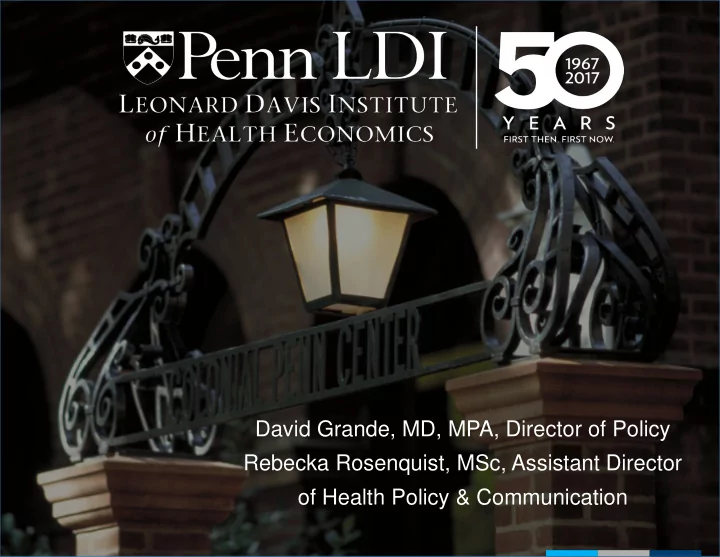

DAN POLSKY, PHD Executive Director David Grande, MD, MPA, Director of Policy Rebecka Rosenquist, MSc, Assistant Director of Health Policy & Communication
S OCIAL MEDIA STRATEGY PennLDI 2
W HAT DO ACADEMICS SAY ABOUT SOCIAL MEDIA ? Traditional Social Direct P-value 3 Media Media Outreach Perceived efficacy 1 6.7 6.6 7.3 0.06 Self-confidence 1 7.0 5.4 6.0 <0.001 Peer respect 1 7.7 5.8 7.4 <0.001 Academic 7.1 5.2 5.9 0.003 promotion 1 Overall impression 2 73.2 69.0 75.6 0.04 1 1-10 scale where 1=not at all and 10=very 2 0- 100 scale where 0 = “cold” feeling about researcher and 100 = “warm” feeling toward researcher 3 P-values calculated using ANOVA and test for a difference between experimental groups. PennLDI 3
T HEY WERE USING TRADITIONAL DISSEMINATION METHODS Directly Contacted Policymaker 74.4% Interviewed by Reporter 69.7% News Media Covered Your Study 65.1% Contacted Interest Group 63.2% Published Policy Brief 33.5% Published Editorial with Policy Recs 30.7% Blogged about Research/Policy 20.9% Updated Facebook Friends about… 19.1% Tweeted about Research 14.4% 0% 20% 40% 60% 80% Respondents were asked to self-report whether they had used any of the above communication methods in the past year. PennLDI 4
W HAT MADE THEM NERVOUS ? Professional Risk Culture Low Uncertainty Confidenc of Efficacy e Grande et al., Health Affairs , 33, no.7 (2014):1278-1285 PennLDI 5
T HERE IS MORE DISTRUST THAN YOU THINK PennLDI 6
H OW CAN YOU REACH POLICYMAKERS ON SOCIAL MEDIA ? PennLDI 7
H OW CAN YOU REACH POLICYMAKERS ON SOCIAL MEDIA ? 115 had public accounts (63%) 184 identified on Twitter (33%) 558 staff 69 had private members accounts (37%) 374 not identified on Twitter (67%) PennLDI 8
T OP HEALTH SOURCES N AME F OLLOWERS T WEETS # S TAFF F OLLOW Sarah Kliff 35,079 10,987 26 Brendan Buck 11,700 9,040 16 Chelsea Clinton 556,776 2,048 16 HHS.gov 399,315 3,227 14 HealthCare.gov 175,683 1,513 14 Energy and Commerce 17,019 5,346 14 Planned Parenthood 111,147 14,783 13 Sen. Tom Coburn M.D. 78,052 1,300 13 NYTimes Health 638,468 20,472 12 The Hill Healthwatch 14,294 8,783 11 NPR Health News 478,127 8,775 10 Kathleen Sebelius 39,359 778 9 WSJ Health News 374,706 8,073 9 DC Fire and EMS 21,905 16,933 9 Kaiser Family Found 46,722 6,019 8 WHO 1,363,230 11,329 8 Jennifer Haberkorn 6,557 6,186 8 Health_Affairs 77,566 3,464 7 Kaiser Health News 73,652 7,228 7 PennLDI 9
T OP SOURCES OVERALL ( NON - HEALTH ) Individuals Academic 23 (1.9 %) Political-Governmental 329 (27.4 %) Advocacy-Interest Groups 48 (4.0 %) News Media 446 (37.1 %) Organizations Academic 3 (0.2 %) Political-Governmental 107 (8.9 %) Advocacy-Interest Groups 95 (7.9 %) News Media 180 (15.0%) PennLDI 10
PennLDI 11
I S IT WORTH IT ? • Researchers are slow to adopt and the norms of social media can conflict with academia • Social media strategy may not completely disrupt information channels – but it is a new tool to power them • Academics need help PennLDI 12
A UNIVERSITY - BASED RESEARCH INSTITUTE Why we use social media (Twitter)… • To promote our experts, their work, our coverage of their work • To build reputation around certain areas of research • Connect with…media, influencers, policymakers (?) • Be an actor in the health policy space PennLDI 13
T HE INSTITUTIONAL ADVANTAGE P lay a role that researchers aren’t comfortable with P roblem we’re trying to solve for: • Thinking like a ‘public intellectual’ • Being willing to generalize • Self-promotion embarrassment • Fear of getting something wrong • Academic promotion incentives PennLDI 14
A ND DISADVANTAGE … • Careful about our ‘voice’ • Aim to be an institute with personality • Twitter is a community of individuals • Finding the balance between promotion and usefulness PennLDI 15
T HINGS THAT HAVE WORKED • Graphics • Hooking up to what others are talking about • Promoting someone who’s writing about our research or researchers (everyone likes being promoted) PennLDI 16
17
18
PennLDI 19
K EY VALUE OF SOCIAL MEDIA • Following policy, instead of research, cycle • ‘Dusting off’ old findings – give them new life when policy relevant • May not reach policymakers (Dave’s research) but reach influencers • Not just a push strategy – key source of info about publications, policy developments, hot topics PennLDI 20
E XAMPLE : WHY ACADEMICS SHOULD TWEET PennLDI 21
C HALLENGES • Efforts in content production and success of a Twitter strategy don’t always match • Continued reticence among (some) faculty • Breaking through the noise • Being publicly available…for better or worse • How to measure impact? • ‘impressions’, ‘engagement‘, # of followers OR quality of followers PennLDI 22
THANK YOU! D AVID G RANDE @ DAVEGRANDE DGRANDE @W HARTON . UPENN . EDU R EBECKA R OSENQUIST @P ENNLDI @ REBECKAROSENQU 1 REBECKAR @W HARTON . UPENN . EDU
Recommend
More recommend